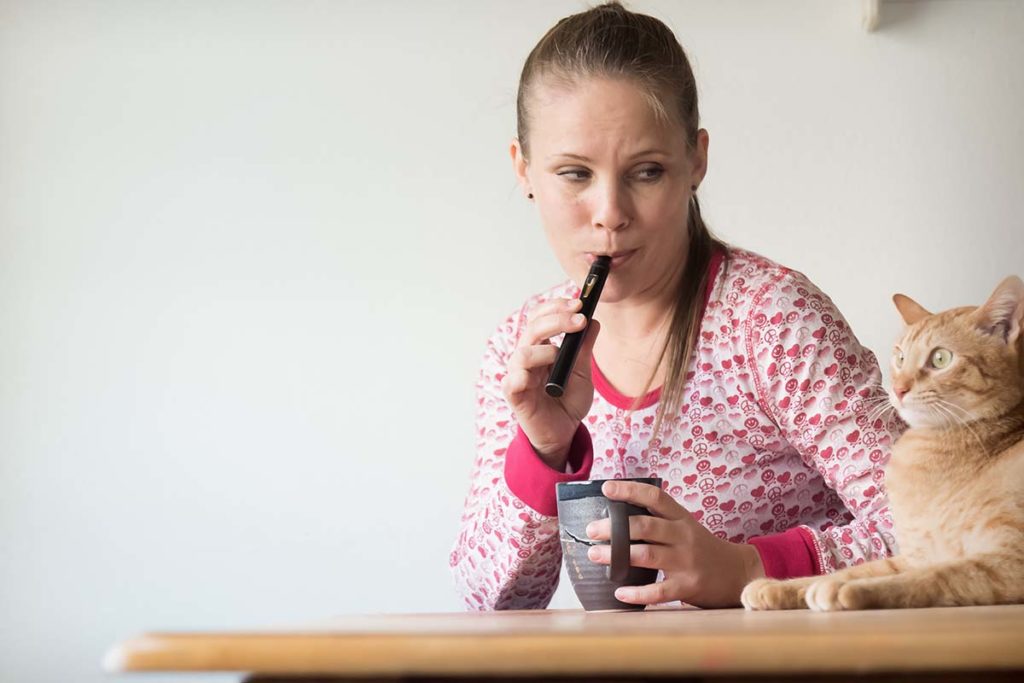As a kid, road trips with my grandparents meant hours listening to Bing Crosby and Glenn Miller on AM radio. It also meant arriving to our destination reeking of Swisher Sweets cigars and Pall Mall cigarettes. My grandparents never thought twice about smoking in the car — windows up — even with kids bouncing around in the backseat.
Thanks to decades of research since, we now know what my grandparents did not. Exposure to secondhand smoke isn’t safe. But there’s another danger you might not know about — thirdhand smoke.
Thirdhand smoke is the chemicals that build up on surfaces over time in a place where people smoke a lot. It can be in a building or vehicle.
It may even be deadly — not just for people, but for our pets, too.
“There is no safe level of exposure,” says tobacco treatment specialist Neely Dahl, MPH, CTTS. “If you want to continue smoking, that’s fine. But it’s not OK to expose others to the many health risks associated with it.”
Second & Thirdhand Smoke: What’s the Difference?
Light up a cigarette, cigar, pipe, or joint, or take a drag of one of these and exhale, and you’re creating secondhand smoke. If it’s a tobacco product, that smoke contains about 7,000 chemicals, 70 of which cause cancer.
Long-Time Smoker?
If you’ve ever been a smoker, a lung cancer screening could save your life.
Thirdhand smoke isn’t actually smoke. Rather, it’s the buildup of chemicals that linger on surfaces. These include nicotine and cancer-causing chemicals formaldehyde, naphthalene, and others. It gets into soft surfaces like clothes and settles on hard surfaces like walls and floors.
You can’t air it out and most household cleaners can’t get it out. Even if you only smoke in one part of a building it can get into the other parts. It stays behind for months even after people stop smoking in a place.
Why Is Second & Thirdhand Smoke Dangerous?
Around 41,000 people die each year from exposure to secondhand smoke, according to the Centers for Disease Control and Prevention. Even brief exposure can be harmful to your health. Inhaling secondhand smoke — aka involuntary smoking — irritates your airways and damages blood vessels. Plus, it increases your risk for heart disease and lung cancer by as much as 30%.
In adults, secondhand smoke also can cause:
- Heart attack
- Stroke
- Eye problems like dry eye
- Breast, bladder, and other cancers
- Reproductive problems
Infants and children exposed to secondhand smoke are at greater risk for:
- Asthma
- SIDS (sudden infant death syndrome)
- Ear infections
- Breathing problems
You can be exposed to thirdhand smoke by touching surfaces or breathing gases they release. Infants and children are at greater risk of exposure because of crawling on the floor or putting things in their mouths.
The Danger to Your Pets
If you smoke around your pets, you’re putting them at risk for health problems. And it’s not just secondhand smoke you have to worry about. According to the U.S. Food and Drug Administration, thirdhand smoke can impact pets, too. Pets can absorb these chemicals through their skin, eat them, or inhale them.
Dogs exposed to secondhand or thirdhand smoke are more likely to have:
- Breathing problems
- Allergies
- Nose cancer, especially dogs with longer snouts
- Lung cancer, particularly short-nosed dogs
Cats whose owners smoke are at greater risk for:
- Mouth cancer
- Lung cancer
- Asthma
- Lymphoma (cancer of the lymph nodes)
“Pets are part of our family. It’s important that people recognize how secondhand and thirdhand smoke can affect their health, too,” says Dahl.
What About Vaping?
Vaping is still a fairly new habit compared with other tobacco products. We need more time and research to understand how it impacts the body. But what we do know for certain is that inhaling a whole bunch of chemicals, not to mention small metal particles, isn’t good for you.
And that massive plume of aerosol full of toxins that you exhale while vaping? That isn’t good for anyone who happens to be near you. “There are about 2,000 chemicals in vaping aerosol,” says Dahl. “Whatever the smoker is inhaling is also being exhaled. So it’s just as harmful to a bystander.”
How harmful? According to the American Heart Association, inhaling vaping aerosol secondhand can cause bronchitis symptoms and shortness of breath. It can also worsen heart and lung disease.
Vaping is on the rise among kids and teens, in particular. Even if your child isn’t vaping, be sure to make them aware of the risks of aerosol exposure so they can avoid being in closed spaces with friends who do.
